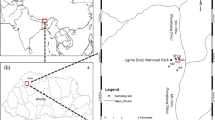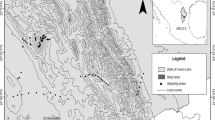Abstract
Classification and ordination of plant formations are presented for a seasonally flooded plain of the Brazilian Pantanal. Phytosociological data were collected on 10 physiognomically distinct formations during the rainy, flood, and dry seasons. The degree of association among plant species was measured with Jaccard similarity index, and both Jaccard similarity index and Bray Curtis distance index were employed to classify sample units into similar groups. The ordination of plant species and sample units were performed with Correspondence Analysis. Four groups of plant formations were significantly distinct on a quantitative basis: marsh ponds/waterlogged basins, short grasslands, tall grassland/scrub, and forest-edges. These formations were ordered along a gradient of topographic relief from depressions with permanent standing water (marshes) through flats subject to seasonal flooding (grasslands and scrub) and mounds of sandy soil above the flood level (forests). Although hydroperiod appears to be one of the most important variables, the distribution of plant species within wetlands is most probably explained by the interaction of many additional factors. A few plant species could be used as indicators of the local hydrological and edaphic conditions, e.g., Eleocharis elegans, Aeschynomene fluminensis, Hydrolea spinosa, and Hymenachne amplexicaulis for marsh ponds, and Caperonia castaneifolia, Diodia kuntzei, and Eleocharis acutangula for waterlogged basins. The procedure presented in this study could be developed as a tool for the inventory and management of the Pantanal and other palustrine wetland habitats.
Similar content being viewed by others
References
Adámoli, J. 1986. Fitogeografia do Pantanal. Anais do simpósio sobre recursos naturais e sócio-econômicos do Pantanal, EMBRAPA, Brasília, Brazil 5: 105-106.
Alho, C. R. J., Lacher, T. E. & Goncąlves, H.C. 1988. Environmental degradation in the Pantanal ecosystem. Bioscience38: 164-171.
Allen, A. C. & Valls, J. F. M. 1987. Recursos forrageiros nativos do Pantanal Mato-grossense. EMBRAPA-CENARGEN,Brasília, Brazil, Documentos 8.
Brasil. 1982. Projeto RADAMBRASIL, 27. Ministério das Minas e Energia, Brasília, Brazil.
Brum, P. A. R., Sousa, J. C., Comastri Filho, J. A. & Almeida, I. L. 1987. Deficiências minerais de bovinos na sub-região dos Paiaguás, no Pantanal Mato-grossense. Pesq. Agrop. Bras. 22: 1039-1048.
Clifford, H. T. & Stephenson, W. 1988. An introduction to numerical classification. Academic Press, New York, U.S.A.
Conrad, J. H., McDowell, L. R., Ellis, G. L. & Loosli, J. K. 1985. Minerais para ruminantes em pastejo em regiões tropicais. University of Florida, Gainesville, USA.
Cowardin, L. M. & Golet, F. C. 1995. US Fish and Wildlife Service 1979 wetland classification: A review.Vegetation 118: 139-152.
Crocker, R. L. & Tiver, N. S. 1948. Survey methods in grassland ecology. J. Br. Grassld Soc. 3: 1-26.
Cronquist, A. 1981. An Integrated System of Classification of Flowering Plants. Columbia University Press, New York, USA.
Eiten, G. 1985. Vegetation near Santa Teresinha, NE Mato Grosso. Acta Amazonica 15: 275-301.
Finlayson, C. M. & van der Valk, A. G. 1995. Wetland classification and inventory: A summary. Vegetatio 118: 185-192.
Frey, R. 1995. Flora and vegetation of 'Las Piedritas' and the margin of Laguna Cáceres, Puerto Suárez, Bolivian Pantanal. Bull. Torrey Bot. Club 122: 314-319.
Gopal, B. & Sah, M. 1995. Inventory and classification of wetlands in India. Vegetatio 118: 39-48.
Goslee, S. C., Brooks, R. P. & Cole, C. A. 1997. Plants as indicators of wetland water source. Plant Ecol. 131: 199-206.
Guarim Neto, G. 1984. Plantas do Brasil - angiospermas do Estado de Mato Grosso - I. Rodriguésia 36: 105-121.
Guarim Neto, G. 1991. Plantas do Brasil - angiospermas do Estado de Mato Grosso - Pantanal. Act. Bot. Bras. 5: 25-47.
Haase, R. 1989. Plant communities of a savanna in northern Bolivia: I. Seasonally flooded grassland and gallery forest. Phytocoenologia 18: 55-82.
Haase, R. 1990. Plant communities of a savanna in northern Bolivia: II. Palm swamps, dry grassland, and shrubland. Phytocoenologia 18: 343-370.
Hoehne, F. C. 1923. Phytophysionomia do Estado de Mato-Grosso e ligeiras notas a respeito da composiç ão e distribuiç ão da sua flora. Melhoramentos, São Paulo, Brazil.
Hoehne, F. C. 1936.O grande Pantanal de Mato Grosso. Bol. Agric., São Paulo 1936: 443-470.
Legendre, L. & Legendre, P. 1984. Écologie numérique. v. 2. Masson, Paris, France.
Levy, E. B. 1927. The grassland of New Zealand. Progress of regrassing experiments on deteriored hill county in Whangamomona County I. Interim results of burning and sowing trials: seed mixture recommended for second burns. N.Z.J. Agric. 34: 145-164.
Levy, E. B. & Madden, E. A. 1933. The point method of pasture analysis. N. Z. J. Agric. 46: 267-279.
Ludwig,, J. A. & Reynolds, J. F. 1988. Statistical Ecology: A primer on methods and computing. John Wiley & Sons, New York, USA.
Mantovani, W. & Martins, F.R. 1990.Ométodo de pontos. Acta Bot. Bras. 4: 95-122.
McCloskey, L.R. 1970. The dynamics of the community associated with amarine scleractinian coral. Int. Rev. Gesamten Hydrobiol. 55: 13-81.
Mirkin, B. M., Kononov, K. E., Gogoleve, P. A., Burtseva, E. I. & Naumova, L. G. 1992. The floodplain grasslands of middle Lena River: II. Classification. Folia Geob. Phyt. 27: 247-300.
Muller, R. N. 1982. Vegetation patterns in the mixed mesophytic forest of eastern Kentucky. Ecology 63: 1901-1917.
Naranjo, L. G. 1995. An evaluation of the first inventory of South American wetlands. Vegetatio 118: 125-129.
Nores, J. G. 1984. Contenido de algunos elementos trazas en praderas naturales uruguayas. R, Fac. Agron. 35: 23-25.
Pinder, L. 1997. Niche Overlap Among Brown Brocket Deer, Pampas Deer, and Cattle. Ph.D. dissertation, University of Florida, Gainesville, USA.
Por, F. D. 1995. The Pantanal of Mato Grosso (Brazil). Kluwer Academic Publishers, London, U.K.
Pott, A. 1988. Pastagens do Pantanal. EMBRAPA-CPAP, documentos 7, Corumbá, Brazil.
Pott, E. B., Brum, P. A. R., Almeida, I. L., Comastri Filho, J. A. & Dynia, J. F. 1987. Nutriç, ão mineral de bovinos de corte no Pantanal Mato-Grossense. Pesq. Agropec. Bras. 22: 1093-1109.
Pott, E. B., Almeida, I. L., Brum, P.A. R., Comastri Filho, J.A., Pott, A. & Dynia, J. F. 1989. Nutriç ão mineral de bovinos de corte do Pantanal Mato-Grossense: 2. Micronutrientes na Nhecolândia (Parte Central). Pesq. Agropec. Bras. 24: 109-126.
Prance, G. T. & Schaller, G. B. 1982. Preliminary study of some vegetation types of the Pantanal, Mato Grosso, Brasil. Brittonia 32: 223-251.
Ramsar Convention Bureau. 1990. Directory of Wetlands of International Importnace. Ramsar Convention Bureau, Gland, Switzerland.
Ratter, J. A., Pott, A., Pott, V. J., Cunha, C. N. & Haridasan, M. 1989. Observations on woody vegetation types in the Pantanal and at Corumbá, Brazil. Notes RBG Edinb. 45: 503-525.
Rizzini, C. T. 1979. Tratado de Fitogeografia do Brasil: aspectos ecológicos e florísticos, Vol 2. HUCITEC Ltda., São Paulo, Brazil.
Robertson, P. A., Weaver, G. T. & Cavanaugh, J. A. 1978. Vegetation and tree species patterns near the northern terminus of the Southern Floodplain Forest. Ecol. Monogr. 48: 249-267.
Robertson, P. A., Mackenzie, M. D. & Elliot, L. F. 1984. Gradient analysis and classification of the woody vegetation for 4 sites in southern Illinois and adjacent Missouri. Vegetatio58: 87-104.
Scott, D. A. & Jones, T. A. 1995. Classification and inventory of wetlands: A global overview. Vegetatio 118: 3-16.
Semeniuk, C. A. & Semeniuk, V. 1995. A geomorphic approach to global classification for inland wetlands. Vegetatio 118: 103-124.
Shannon, C. E. & Weaver, W. 1949. The mathematical theory of communication. The University of Illinois Press, Urbana, USA.
Spichiger, R., Ramella, L., Palese, R. & Mereles F. 1991. Proposici ón de leyenda para la cartografía de las formaciones vegetales del Chaco paraguayo. Contribuición al estudio de la flora y de la vegetación del Chaco. III. Candollea 46: 541-564.
Ter Braak, C. J. F. 1989.CANOCO- an extension ofDECORANAto analyze species-environment relationships. Hydrobiologia184: 169-170.
Ter Braak, C. J. F. 1990. Update notes: CANOCO version 3.10. Agricultural Mathematics Group, Wageningen, The Netherlands.
Thomas, A. S. 1960. Changes in vegetation since the advent of myxomatosis. J. Ecol. 48: 287-306.
Veloso, H. P. 1948. Considerações sobre a vegetação do Estado de Mato Grosso: (II) notas preliminares sobre o pantanal e zonas de transição. Boletim Geográfico6: 798-943.
Westman, W. E. 1980. Gaussian analysis: identifying environmental factors influencing bell-shaped species distributions. Ecology 61: 733-739.
Whitmann, W. C. & Siggeirson, E. I. 1954. Comparison of line interception and point contact methods in the analysis of mixed grass range vegetation. Ecology 35: 431-436.
Rights and permissions
About this article
Cite this article
Pinder, L., Rosso, S. Classification and ordination of plant formations in the Pantanal of Brazil. Plant Ecology 136, 151–165 (1998). https://doi.org/10.1023/A:1009796616824
Published:
Issue Date:
DOI: https://doi.org/10.1023/A:1009796616824




